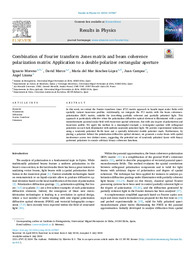Título :
Combination of Fourier transform Jones matrix and beam coherence polarization matrix: Application to a double polarizer rectangular aperture |
Autor :
Moreno, I.
Marco, D.
Sánchez López, María del Mar 
Campos, J.
Lizana, Angel  |
Editor :
Elsevier |
Departamento:
Departamentos de la UMH::Ciencia de Materiales, Óptica y Tecnología Electrónica |
Fecha de publicación:
2024-08 |
URI :
https://hdl.handle.net/11000/34253 |
Resumen :
In this work, we extend the Fourier transform Jones (FTJ) matrix approach to handle input scalar fields with spatially variant transverse profiles. Additionally, we integrate the FTJ matrix with the beam coherence- polarization (BCP) matrix, suitable for describing partially coherent and partially polarized light. This approach is particularly effective when the polarization diffractive optical element is illuminated with a quasi- monochromatic paraxial scalar field with transverse spatial coherence, but with any degree of polarization and transverse profile. We apply the method to a meaningful example: a rectangular aperture with orthogonal polarizers on each half, illuminated with uniform randomly polarized light. We provide experimental validation using a randomly polarized He-Ne laser and a specially fabricated double polarizer mask. Furthermore, by placing a polarizer behind the polarization diffractive optical element, we generate a scalar beam with spatial incoherence across two distinct zones, suggesting the potential use of randomly polarized lasers with binary patterned polarizers to encode arbitrary binary coherence functions.
|
Palabras clave/Materias:
polarization
diffraction
Fourier transform
coherence |
Área de conocimiento :
CDU: Ciencias aplicadas: Ingeniería. Tecnología |
Tipo de documento :
info:eu-repo/semantics/article |
Derechos de acceso:
info:eu-repo/semantics/openAccess
Attribution-NonCommercial-NoDerivatives 4.0 Internacional |
DOI :
https://doi.org/10.1016/j.rinp.2024.107867 |
Aparece en las colecciones:
Artículos - Ciencia de los materiales, óptica y tecnología electrónica
|
 La licencia se describe como: Atribución-NonComercial-NoDerivada 4.0 Internacional.
La licencia se describe como: Atribución-NonComercial-NoDerivada 4.0 Internacional.
.png)
